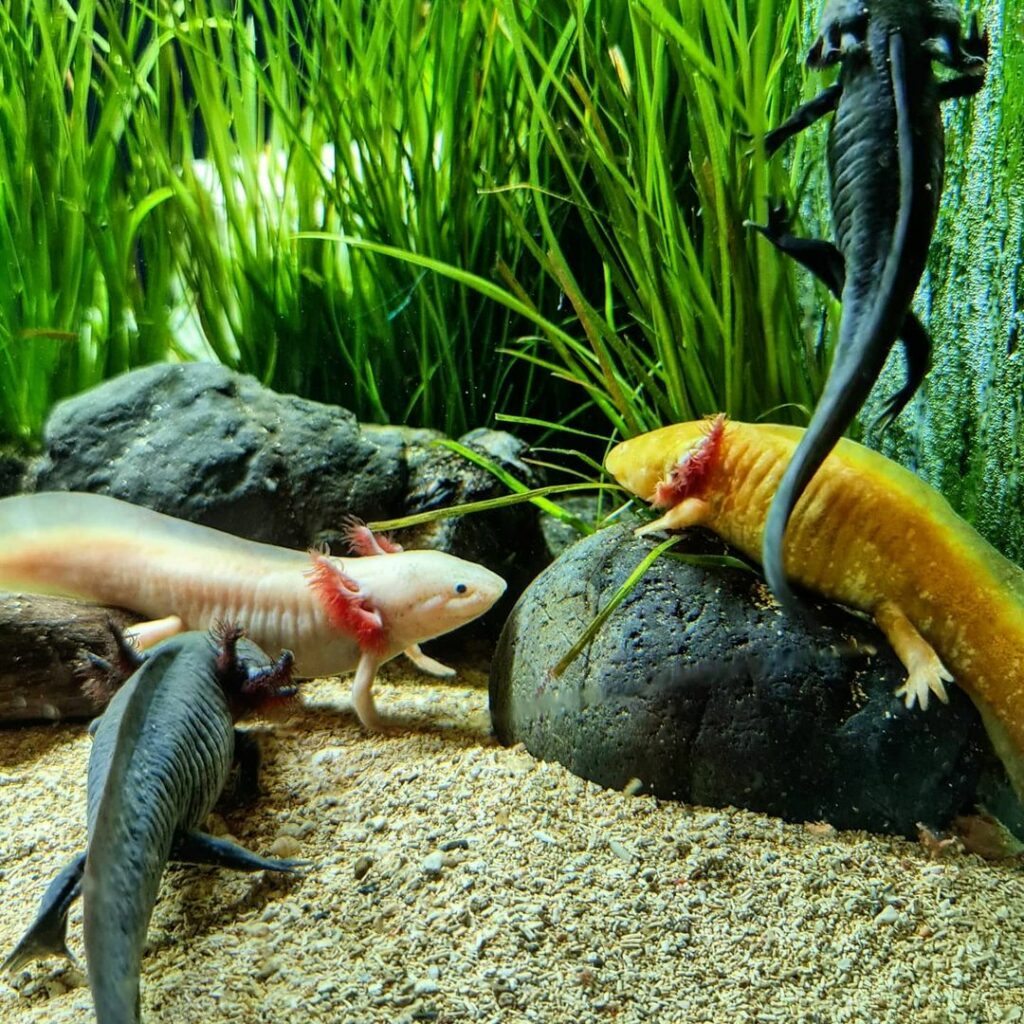- Do axolotls like or need company?
- How to get axolotls to live together?
- 1- A large enough tank for your axolotls
- 2- A highly efficient water filtration system
- 3-Enough hides for all your axolotls
- 4-Enough Food for all the tank mates
- 5- Choose axolotls of similar age and size
- 6- Choose axolotls of the same gender
- 7- Avoid introducing a female axolotl in a tank full of adults
- 8- Quarantine the sick individuals
- Can I keep other species with my axolotl?
- Do axolotls get lonely in the tank?
- Is it better to get two axolotls or one axolotl with other species?
- How big do axolotls get?
- Do axolotls get bored?
- Do axolotls fight each other?
- Final Thoughts
Do axolotls like or need company?
Axolotls don’t like company and don’t need it because they are solitary animals that only seek company during the mating season. Still, it is possible to have them share a tank or live with other species if you provide them with a sufficiently large tank and enough food and hides to avoid triggering their cannibalistic behavior and food or territory-related conflicts with each other.
Can axolotls live together?
Yes, axolotls can live together but they will need to have enough space, food, shelter, and other conditions to avoid conflicts and fights between them.
Here is how to get two or more axolotls to live safely in the same tank :
How to get axolotls to live together?
To avoid conflicts when you put two or more axolotls in the same tank, you must respect some conditions and be always vigilant of what is happening in the tank in order to intervene if necessary, here are the points to take into consideration when you cohabit several axolotls together:
1- A large enough tank for your axolotls
While axolotls can live with enough water to cover their body, they need a lot of space to swim freely and let the water flow over their body and gills.
You will need to choose a suitable tank that is large enough to hold your axolotls, a 40-gallon Breeder can only accommodate two adult individuals.
How many axolotls can live together?
You can put several axolotls together, twenty or so if you like, but they will need a tank of 200 gallons or more.
The larger the axolotls get, the more space, food, privacy, and calm they will need.
It is advised not to put more than 3 axolotls in a less than 60-gallon tank.
2- A highly efficient water filtration system
Two or more axolotls in the same tank will produce more waste, will need more dissolved oxygen in the water, and will therefore cause the production of more ammonia.
You need to install a good water filtration system, a powerful enough filter that will work continuously and most of all collect their poop and food more often.
You will need to clean the media at least 3 times a month and replace 25% of the water in the tank more often (at least 2 to 3 times a month).
You may need a bubbler to better oxygenate the tank water and a chiller to face possible temperature increases.
3-Enough hides for all your axolotls
To avoid conflicts between axolotls in the same tank, you will need to provide some tank decorations and at least one hide for each axolotl and leave enough empty space on the bottom of the tank so that they can rest at the same time and have enough space to drop their food at mealtime.
4-Enough Food for all the tank mates
Axolotls that live together will fight over an earthworm or a piece of meat when they are hungry and you don’t give them enough to eat.
Make sure you give enough food for all your axolotls and above all they all eat the same thing to avoid creating jealousy, to make one of them bigger than the other, and to avoid making them aggressive and awakening their territorial instinct.
5- Choose axolotls of similar age and size
If you want a companion for your axolotl, it is recommended to bring individuals born from the same parents, which are the same size and especially the same kind.
Axolotls can quickly become cannibals if they’re triggered and feel that they can hunt and swallow one of their fellow animals, so avoid introducing baby axolotls into a tank where there are already adults.
Axolotls can also fight over hiding places and the best places to sit, but when they are of the same size, they will avoid conflict to avoid injury.
6- Choose axolotls of the same gender
Unless you want to breed hundreds of baby axolotls (usually around 300 hatched eggs), you should only put together in the same tank axolotls of the same gender
Otherwise, you must watch your axolotls and be ready to install a tank divider and divide the tank into two equal parts to separate the male from the female axolotl during the mating season, of course in early spring
And if you want your axolotls to reproduce, you will have to install live plants and take the male out of the tank at the end of the fertilization process, or collect the eggs and hatch them in a different container.
7- Avoid introducing a female axolotl in a tank full of adults
Never introduce a female axolotl during the mating season in a tank where there is more than one male axolotl, they will surely fight over who will deposit his sperm cones and fertilize the female.
8- Quarantine the sick individuals
You must also be vigilant and monitor the health of your axolotls and you must always be ready to remove from the tank any axolotl that shows symptoms of illness so that it cannot contaminate the water or transmit it to its other tank mates.
Can I keep other species with my axolotl?
There are many other species of fish, crustaceans, and snails that you can keep with your axolotl. However, it is important to take certain precautions in this case. Not only should you know which species can cohabitate with an axolotl (as there are some, like these tetras, that are not recommended), but you should also be aware of the precautions to prevent tank mates from attacking your axolotl, which could potentially cause gill damage or impaction if your axolotl hunts and swallows them.
Do axolotls get lonely in the tank?
Axolotls do not get lonely and what you call “social behavior” when talking about axolotls is not what you think. They don’t seek out the company of other axolotls, they live alone in the wild and they can fight until death to get the other axolotls out of their territory.
Axolotls put in the same tank are tolerant of each other just because they were born in a limited space, lived with other axolotls when they were small, and mostly because there is enough food and hiding places for everyone.
This endangered species live alone in its natural environment in the canals of Lake Xochimilco and each one chooses its own territory and never ventures into the territory of another axolotl under penalty of being attacked.
The only time axolotls can meet is during the mating season in February when the females release pheromones into the water to attract male axolotls to fertilize their eggs.
The adult males will of course fight each other and the strongest one will ensure his offspring by depositing sperm cones on the bottom of the lake and the female will inhale them in her abdomen and fertilize the eggs.
After the end of the nuptial dance and the fertilization of the eggs, the female will chase the males away from the place where she will lay her eggs so that they are not eaten.
As soon as they hatch, a few days later, the baby axolotls will be left to fend for themselves and their mother axolotl will leave to find another territory.
The baby axolotls may stay and live close to each other until they become adults, are discovered by a hunting fish or food runs out and cannibalism begins.
Is it better to get two axolotls or one axolotl with other species?
Axolotls don’t like company and in my opinion, it would be better to keep only one axolotl especially if it is your first aquarium, you can bring other small freshwater fish like White cloud minnows, Small shrimp, and some mini snails.
You will be able to keep the situation under control and once you have learned how to take good care of the axolotl and the tank, you can then consider getting more axolotls why not become a passionate breeder to help save this species and not deprive future generations of its incomparable smile.
How big do axolotls get?
Axolotls can grow to between 9 and 12 inches long (we have seen axolotls that have grown to 18 inches), weigh 300 gr and live 15 years. So, if they have to fight for food, space, a hide, or a female, they will not hesitate to attack another axolotl or engage in cannibalism if a tankmate is small enough to be swallowed.
So if you think your axolotl is bored alone in its tank, consider a larger aquarium, another axolotl of the same size and gender, and above all install another hide and be vigilant, especially in the first few days and when you feed them and the amount of food you give them, they must eat until they are not hungry anymore!
Can smaller axolotls live together?
To begin with, baby axolotls do not grow in the same way, some will grow bigger and taller than others, and males and females also grow differently.
If you are breeding axolotls, you should start sorting the baby axolotls according to their size as soon as they reach one inch (2 to 3 cm).
Axolotls must be kept apart or given more space and food as soon as they reach 2 inches (5 cm) to avoid triggering their cannibalistic behavior and fighting over food and territory.
Females should be separated from males just before they reach adulthood (around 6 months).
Do axolotls get bored?
Axolotls don’t get bored, and they don’t have these “human” feelings, but you can help your axolotl to keep busy from time to time without bringing home another tank mate, here are some examples:
- Adding more floor space
- Installing new elements in the tank
- Adding floating plants
- Offer him new treats
- Interact with him by moving your finger on the glass of the tank or on the surface of the water
- Set up a bubbler
Do axolotls fight each other?
Axolotls can fight each other, especially at mealtimes, if you do not feed them separately.
Axolotls may also fight for a hide or a place on a piece of furniture or a plant, as well as for a female.
Injuries can be severe, large axolotls may eat their young or cut off a piece of their tail or gills.
If you are planning to put two axolotls together, you will need more floor space (a larger tank with more than 60 gallons), more food and better equipment, and more maintenance.
Final Thoughts
Under good housing conditions, axolotls can tolerate the company of other axolotls but do not need them. An axolotl can live on its own for its entire life without feeling lonely.
The only time male and female axolotls may really want company is in the spring, during the mating season.
Females will expect an axolotl male to show up in the tank and fertilize her eggs while male axolotls, under the effect of sex hormones, will naturally visit all corners of the tank hoping to find a female to pass on their genes.



